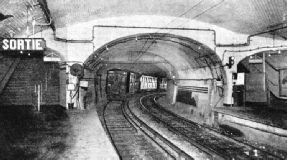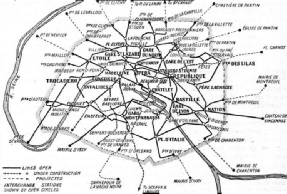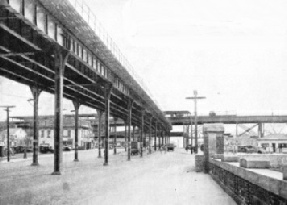

Underground and Overhead Lines
Important Railways Which Serve Foreign Cities

ON THE PARIS UNDERGROUND. A train entering the station of Place d'Italie. The first section of the Paris Metropolitan Railway was opened in 1900 from Porte Vincennes to the Porte Maillot. The line is electrically operated at 600 volts dc. Nearly all the stations are near street-
PROBABLY the first underground railway that the average traveller in Europe is likely to see is the one in Paris The visitor will be struck by its extreme simplicity. There are no lifts, escalators, or visible station buildings. A short flight of steps leads down from the pavement to a passage containing the booking-
The Paris Metropolitan Railway, known locally as the Metro, has a route mileage of eighty-
There are two classes, for either of which a uniform fare is charged, permitting unlimited journeys throughout the day. The ordinary fare is 70 centimes, and the first-
No smoking is permitted anywhere in the train. The carriage doors are not pneumatically operated. All the trains stop at every station. The stations are not elaborately decorated. The French are severely practical. A hundred thousand people, they say, will pass through a station every day, but none will linger. They have, therefore, built their stations sufficient for ordinary comfort, and eliminated superfluous decorations. Moreover, the Metro deals safely with an enormous passenger traffic without adopting the elaborate safety-
On the map the Paris Metro looks even more involved than the London Tube system. None of the lines keep straight; they turn again and again at extraordinary angles. With their interchange system, however -

THE DENSE NETWORK of the Paris Metropolitan Railway is shown on the above map. In one year the railway carried over 863,000,000 passengers. There are some eighty-
Paris has its elevated railway in the Ceinture or girdle system, running on a kind of unending viaduct. The Grande Ceinture, or outer girdle, encircles Greater Paris. Its route mileage is ninety-
New York is equipped both with underground and with elevated railways. In America the underground is invariably called the “subway”. In Great Britain the term is not used in this connotation, except in the title of the Glasgow District Subway. London once had a Tower Subway, a narrow-
In the eighteen-
New York has three distinct systems of subways; the I.R.T., or Inter-
New York’s Lines
New York has no real tube railways. London is built on clay, so that it is comparatively easy to cut down a hundred feet or so, and then bore a tube, but Manhattan is solid rock. The Americans blast out a street with dynamite, lay their subway, and then cover in again above it. At intervals in the “blocks” comes a station; it is a short flight of stairs down from the pavement. The passenger drops a coin into a slot, passes a turnstile, and reaches the platform. No tickets are issued, single or return. There are no first-
That is why the I.R.T. subway is plastered with advertisements begging the traveller, as a favour, not to use it, but to book instead on the Elevated, or “L”, as it is colloquially known. That, too, belongs to the Interborough Rapid Transit, and with the same five-
The Elevated is a railway running on giant stilts above the main road. The first section was opened in 1878, and began as a steam line. It had no signals in those far-
There are four Elevated lines in Manhattan itself, with more across the East River in Brooklyn. There are the 2nd and 3rd Avenue lines on the East Side, and the 6th and 9th Avenue lines on the West Side. The famous Fifth Avenue is the dividing point in New York’s geography, with East and West on either side of it. In New York “up-
While we are dealing with the elevated and underground railways of New York, we ought not to forget the Hudson Tubes. There are two great rivers round Manhattan Island, the East River and the Hudson, to say nothing of the small Harlem River. There are bridges over the East River even at its widest, but the Hudson is so much wider that no bridge is possible for a long way up. The Hudson Tubes were built instead. They must not be confused with the Holland Tubes, which are under-
Subways and elevated railways exist also in Boston, Philadelphia, and Chicago. The famous Chicago “Loop” owes its name to the local “L”; it is the part of the city circled by the Elevated, and of course it is the business and finance part. Chicago once had a famous gangster murder on its subway. That was in 1930, and the murdered man was a Mr. “Jake” Lingle. The murderer chose a rush hour, and escaped unnoticed in the crowd.

THE NEW YORK ELEVATED was first opened in 1878, and was then steam operated and had no signals. To-
Chicago boasts a purely goods subway, which is probably unique. The construction was the idea of one of the private telephone companies that operate in the States. It had to lay its tens of thousands of wires somewhere, and, with overhead lines forbidden in the streets, it was obliged to build tunnels for them. The idea occurred of making them large enough to take small freight trains. Why drive the people underground? said the company. Drive the goods underground, do away with the street lorries, and let the people have the benefit of clearer streets. The line was built to connect with every great warehouse; this also runs along the basements of the skyscrapers, and brings them the coal for their furnaces and takes away their refuse. With the coming of the motor, however, traders were unwilling to unload their stuff and then pack it again on the subway cars; and Central Chicago to-
The American lines operate on the third-

THE NEW YORK ELEVATED. This photograph shows how the track is carried above the streets.
At Oslo, the capital of Norway, there is an underground railway which began as a country line. It originally connected Holmenkollen and Frognersaeter, two mountainous pleasure resorts close to the capital. Recently the company thought it would benefit by picking up its clients in the middle of the city. The line was extended underground, and a station was built under Oslo's National Theatre. Passengers may now travel from the heart of the city to the top of the little mountain park in thirty-
Vienna has an underground railway which takes a most irregular course. It was built for strategic purposes in the days of the Austro-
The Metropolitana of Naples starts underneath the Central Station and has a route-
Berlin has numerous underground and elevated railways. Several years ago it built its Stadtbahn, or City Railway. This began as a connecting link between the main lines from east to west, but it was soon extended as a purely local line. The Berlin Underground, or U-
Unusual Lines
In 1928, after a working agreement had been made between the elevated and underground railways, the tramways, and the omnibus companies, the three companies were amalgamated and formed into the Berlin Transport Company. The railway route mileage is fifty. The uniform fare on the Underground is twenty-
The Budapest Underground -
The underground railway at Sydney, Australia, is not of any very great extent, having been recently built merely as a relief to the suburban traffic of the mainline railways; it was then, for convenience, carried underground through the centre of the city. It runs round in a loop, with low-
An oddity exists in Hamburg in connexion with the Hochbahn, which means the “high” or elevated railway. For several stations the “elevated” is running underground. A similar anomaly exists in the USA. When Boston City had finished the building of its new subway the corporation leased the line to the Boston Elevated Company. The “L” lines, now gradually being abolished, were the earlier, and so in several instances the newer subways are part of “Elevated” systems.
In the great cities of America this plan of lease is common. The subway is looked upon as an absolute necessity of life in the crowded centres; its construction cannot possibly pay commercially, and no private company could consider the venture. The city will, therefore, build the subway line itself, and will charge up the costs to rates and taxes. It will then often lease it out to some company to work. In Chicago the “L” systems alone in one year carried 226 million passengers, while in Philadelphia the North Broad Street Subway cost the city one hundred million dollars, or roughly £20,000,000, to construct; its working was then leased to the Rapid Transit Company. Fares vary with the different cities, and with the terms on which the systems were laid down. In New York it is possible to take a direct subway run of twenty-

THE JEROME AVENUE LINE on the New York Interborough Rapid Transit system. On this system there are 138 miles of elevated track and 263 miles of subway, the track is all electric, and of the 4 ft. 8½-
You can read more on
“Chicago’s Unique Underground”,
“Elevated and Mono-
on this website.